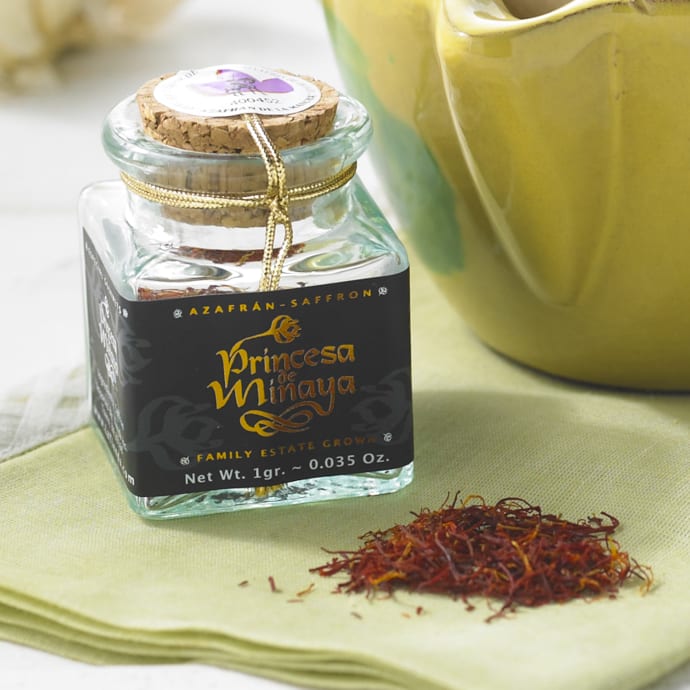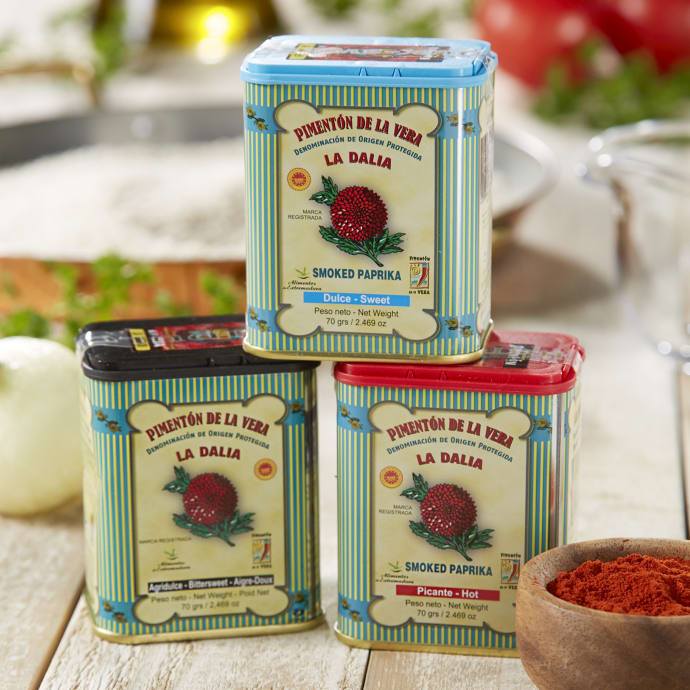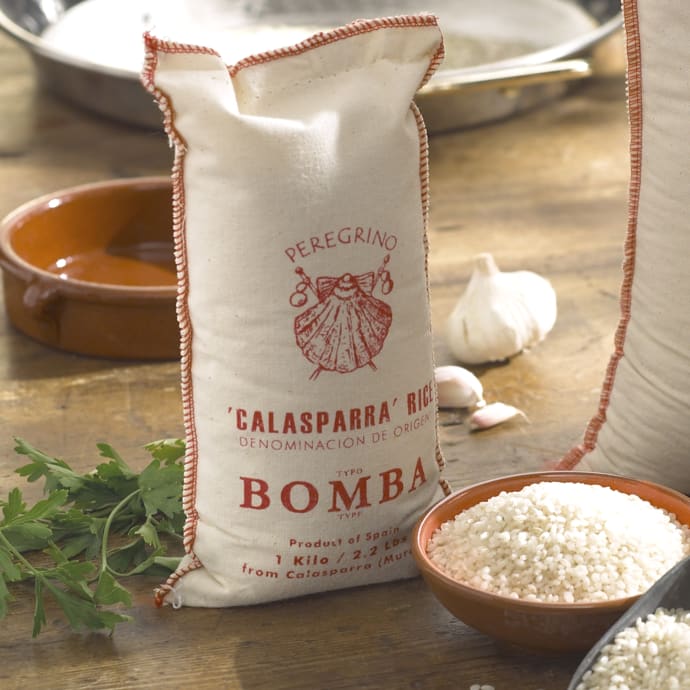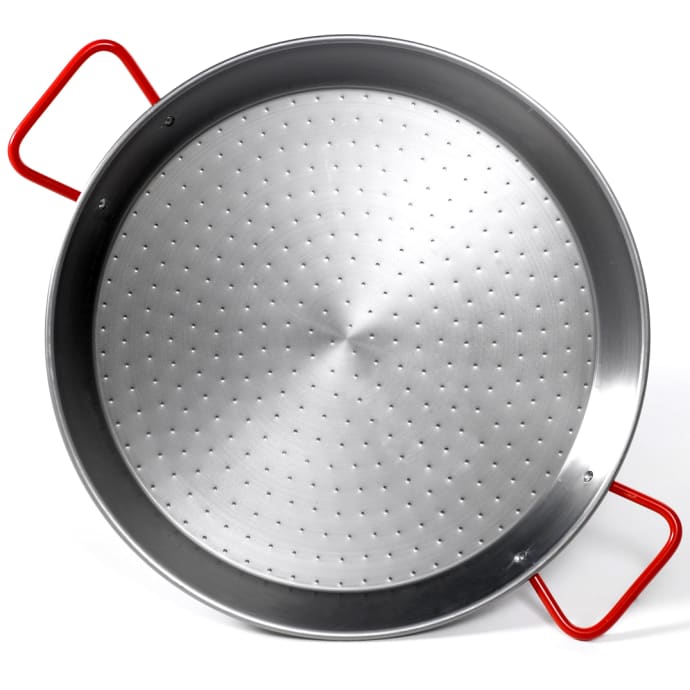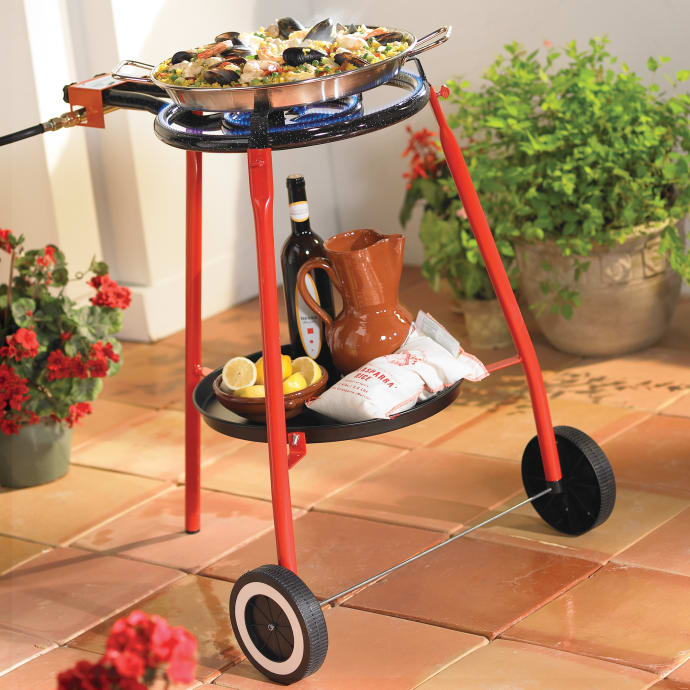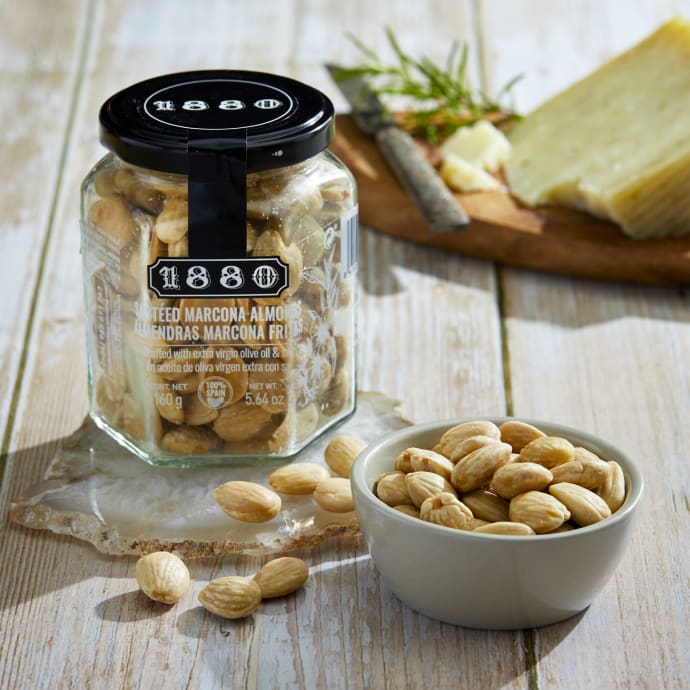Three Kings Sale - Up to 40% Off! Shop Sale

The Perfect Paella
The Wall Street Journal
-
September 25, 2010
A food writer's quest to recapture her glorious past via a handful of rice
Katy McLaughlin
Before I became a newspaper journalist, an SUV-driving wife and soccer mom, I ran a flamenco dance company of Spanish Gypsies in Seville. Long story, whose bottom line is the trade-offs have been in my favor, except for one thing: I miss the taste.
The winning version of this Spanish classic involves a slug of sherry and a chef with good listening skills.
I would say I miss the food, but that's not quite it. There are few Spanish items I can't get in Los Angeles — there are great specialty shops where I can buy everything from ambrosial Iberian ham to pickled white anchovies called boquerones. But paella is a different story. There's a certain, ineffable combination of textures—the best paella rice is both creamy and crunchy—and flavors—of tomato, of saffron, of paprika, of brine, of sherry and of garlic, that add up to something you can't find on an ingredient list: A hot, dry day in Seville, the intensity of the world of flamenco and the Gypsies, my own youth. It's the taste of a time and place to which I can never truly return.
This summer I wanted to try to recapture that essence in a paella. Paella is notorious for being a dish, like Texas barbecue, that is easy to make decently but nearly impossible to perfect. But if I could find the right recipe, and practice it weekly, I might be able to conjure up the past in a handful of rice.
I set off to buy a paella pan, which is surprisingly easy to come by these days in well-stocked cookware stores. The pan is the one essential, common element in a vast array of recipes. It needs to be shallow, ideally made of carbon steel, and enormous — my 18-½-inch diameter pan fits a mere two cups of rice. While paella can contain a wide variety of vegetables, meats and fish, they should all be used sparingly. The rice should be cooked in a thin layer and remain slightly firm, ideally with a crispy, toasted bottom layer.
Once in possession of a proper pan, I turned to the experts for authentic recipes and techniques.
I tried a recipe from the great Spanish chef José Andrés, who calls for a salmorra, a slowly stewed concentration of tomato, peppers, paprika and sugar as a flavor base. Guided by Steven Raichlen, the barbecue guru, I made my paella on the grill with wood chips, a nod to the Spanish tradition of cooking it over a bonfire. Joyce Goldstein, a prolific author of Mediterranean cookbooks, definitively answered my question about the rice-to-liquid ratio, fixing it at a perfect one part rice to two and half parts liquid. I picked up the flavor-boosting tip of stirring in a puree of almonds, parsley and garlic from a little cookbook simply titled "La Paella."
My friend Danielle, who grew up in Málaga, came over and made me paella using a little baggie of spices and Bay leaves she'd smuggled back from Spain. With a wink, she added a good cup of wine to the pan, something I'd never seen before. I spent an hour on the phone with Iñigo Oyarzabal, manager at Taberna del Alabardero in Seattle, whose training included four months on paella duty at a sister restaurant in Marbella. His invaluable contribution was that "paella is a dish you cook with your ears." A light popping sound at the end of cooking says the bottom rice is toasting beautifully.
I made a paella nearly every week this summer, spending a fortune on shellfish and $6-a-pound Bomba rice imported from Spain. My family — and several neighbors — developed connoisseurship for the optimal texture of paella rice. Each of the paellas was slightly different and all delicious.
But all I could think as I ate each one was this: This is not it. None of them made me giddy and melancholy at the same time. I decided to take a break. Maybe the elusive taste was impossible to recreate. Or maybe I'd just forgotten what I was looking for.
A few weeks ago, I had some friends over and needed a meal. The cupboard was bare of imported rice, seafood, salmorra and chorizo sausage — and the grill was out of gas, to boot. While drinking beer, chasing kids and chatting, I tossed some grated tomato, chicken, saffron, paprika and a handful of mushrooms into my paella pan on the stovetop. Low on wine, I settled on a splash of sherry, then tossed in cheap Calrose rice. Toward the end of cooking, I topped my creation with frozen peas. I served it to the table, babbling disclaimers and excuses.
Then I took a bite and blinked back tears, for there it finally was: Rice singing in a chorus of bright top notes (the tomato, the parsley) mingled with mysterious dark notes (the sherry, the mushrooms), set against a crackling toasted base — all improvised, just like flamenco. It took my subconscious to write a recipe for my memory.
Tip: To keep the paella pan from rusting between uses, dribble vegetable oil onto a folded paper towel and wipe it over the surface of the pan. Before using again, wash thoroughly with soap and water.
---
Getting Paella Right
The Rice
Bomba and Calasparra are two varieties considered best for paella in Spain. Don't use long grain. If you have to substitute, use arborio or Calrose.
Marcona Almonds
Seek out this rounder, sweeter variety—typically fried in olive oil—for use in the dish and as a pre-paella snack.
Piquillo Peppers
Decorate the finished paella with thin slices as a garnish. Don't substitute a spicy variety—paella is never spicy.
Pimentón de La Vera
Seek out pimentón from La Vera or look for the words "smoked Spanish paprika." Just don't use the Hungarian kind as it has an entirely different taste.
Manzanilla Sherry
Manzanilla, amontillado and oloroso are great for cooking and sipping. Sweet and cream sherries aren't paella-friendly.
All items available at tienda.com.
----
The Recipe
Serves 6
1/3 cup plus 2 tablespoons extra-virgin olive oil
3 large, ripe tomatoes
1 teaspoon sweet pimentón de la Vera (Spanish smoked paprika)
¼ teaspoon saffron threads
1½ pounds chicken thighs,
preferably boneless and skinless, chopped into bite-size pieces
Kosher salt, freshly ground black pepper
½ pound mixed mushrooms, such as shiitake, portobello, cremini and oyster, cut into large dice
4½ cups chicken stock
½ cup dry sherry
2 cups Calrose rice
10 blanched almonds, ideally Marcona
1 clove garlic
½ bunch of Italian parsley
½ cup frozen peas
1. Slice tomatoes in half, and grate each on a box grater over a bowl. Discard skins; set pulp aside.
2. Heat 2 tablespoons olive oil in a large pan over high heat. Lightly season chicken pieces with salt and pepper, and brown on both sides until deep golden. Remove chicken from pan and set aside.
3. Fry mushrooms until browned in oil and chicken fat. Set aside.
4. Set 18-inch paella pan over two burners at high heat on the stove top, and heat 1/3 cup olive oil. Add tomato pulp and cook until darkened, about 5 minutes. Add paprika and saffron, and cook for about 1 minute. Add chicken pieces and mushrooms; add sherry and cook until evaporated. Add chicken stock; bring to a boil.
5. In a food processor or mortar, puree parsley, garlic and almonds, with a tablespoon or two of water until smooth and stir into pan.
6. Sprinkle rice across the pan and stir until the grains are submerged, then don't stir again. Cook on high heat for 10 minutes, rotating the pan on the two burners to distribute heat. Using a small spoon, test rice and stock and add salt as needed. Reduce heat to medium-low and continue cooking for 6 minutes. Test rice again. If it is still hard, continue cooking for 2-4 more minutes.
7. In the final 2 minutes, sprinkle frozen peas over the top and return heat to medium-high, listening for a crackling sound to ensure the bottom is toasting but not burning. Remove from heat, cover with paper towels and let sit for 5 minutes.
8. Use a metal spoon to scrape toasted rice from bottom of pan and serve.
Katy McLaughlin
Before I became a newspaper journalist, an SUV-driving wife and soccer mom, I ran a flamenco dance company of Spanish Gypsies in Seville. Long story, whose bottom line is the trade-offs have been in my favor, except for one thing: I miss the taste.
The winning version of this Spanish classic involves a slug of sherry and a chef with good listening skills.
I would say I miss the food, but that's not quite it. There are few Spanish items I can't get in Los Angeles — there are great specialty shops where I can buy everything from ambrosial Iberian ham to pickled white anchovies called boquerones. But paella is a different story. There's a certain, ineffable combination of textures—the best paella rice is both creamy and crunchy—and flavors—of tomato, of saffron, of paprika, of brine, of sherry and of garlic, that add up to something you can't find on an ingredient list: A hot, dry day in Seville, the intensity of the world of flamenco and the Gypsies, my own youth. It's the taste of a time and place to which I can never truly return.
This summer I wanted to try to recapture that essence in a paella. Paella is notorious for being a dish, like Texas barbecue, that is easy to make decently but nearly impossible to perfect. But if I could find the right recipe, and practice it weekly, I might be able to conjure up the past in a handful of rice.
I set off to buy a paella pan, which is surprisingly easy to come by these days in well-stocked cookware stores. The pan is the one essential, common element in a vast array of recipes. It needs to be shallow, ideally made of carbon steel, and enormous — my 18-½-inch diameter pan fits a mere two cups of rice. While paella can contain a wide variety of vegetables, meats and fish, they should all be used sparingly. The rice should be cooked in a thin layer and remain slightly firm, ideally with a crispy, toasted bottom layer.
Once in possession of a proper pan, I turned to the experts for authentic recipes and techniques.
I tried a recipe from the great Spanish chef José Andrés, who calls for a salmorra, a slowly stewed concentration of tomato, peppers, paprika and sugar as a flavor base. Guided by Steven Raichlen, the barbecue guru, I made my paella on the grill with wood chips, a nod to the Spanish tradition of cooking it over a bonfire. Joyce Goldstein, a prolific author of Mediterranean cookbooks, definitively answered my question about the rice-to-liquid ratio, fixing it at a perfect one part rice to two and half parts liquid. I picked up the flavor-boosting tip of stirring in a puree of almonds, parsley and garlic from a little cookbook simply titled "La Paella."
My friend Danielle, who grew up in Málaga, came over and made me paella using a little baggie of spices and Bay leaves she'd smuggled back from Spain. With a wink, she added a good cup of wine to the pan, something I'd never seen before. I spent an hour on the phone with Iñigo Oyarzabal, manager at Taberna del Alabardero in Seattle, whose training included four months on paella duty at a sister restaurant in Marbella. His invaluable contribution was that "paella is a dish you cook with your ears." A light popping sound at the end of cooking says the bottom rice is toasting beautifully.
I made a paella nearly every week this summer, spending a fortune on shellfish and $6-a-pound Bomba rice imported from Spain. My family — and several neighbors — developed connoisseurship for the optimal texture of paella rice. Each of the paellas was slightly different and all delicious.
But all I could think as I ate each one was this: This is not it. None of them made me giddy and melancholy at the same time. I decided to take a break. Maybe the elusive taste was impossible to recreate. Or maybe I'd just forgotten what I was looking for.
A few weeks ago, I had some friends over and needed a meal. The cupboard was bare of imported rice, seafood, salmorra and chorizo sausage — and the grill was out of gas, to boot. While drinking beer, chasing kids and chatting, I tossed some grated tomato, chicken, saffron, paprika and a handful of mushrooms into my paella pan on the stovetop. Low on wine, I settled on a splash of sherry, then tossed in cheap Calrose rice. Toward the end of cooking, I topped my creation with frozen peas. I served it to the table, babbling disclaimers and excuses.
Then I took a bite and blinked back tears, for there it finally was: Rice singing in a chorus of bright top notes (the tomato, the parsley) mingled with mysterious dark notes (the sherry, the mushrooms), set against a crackling toasted base — all improvised, just like flamenco. It took my subconscious to write a recipe for my memory.
Tip: To keep the paella pan from rusting between uses, dribble vegetable oil onto a folded paper towel and wipe it over the surface of the pan. Before using again, wash thoroughly with soap and water.
---
Getting Paella Right
The Rice
Bomba and Calasparra are two varieties considered best for paella in Spain. Don't use long grain. If you have to substitute, use arborio or Calrose.
Marcona Almonds
Seek out this rounder, sweeter variety—typically fried in olive oil—for use in the dish and as a pre-paella snack.
Piquillo Peppers
Decorate the finished paella with thin slices as a garnish. Don't substitute a spicy variety—paella is never spicy.
Pimentón de La Vera
Seek out pimentón from La Vera or look for the words "smoked Spanish paprika." Just don't use the Hungarian kind as it has an entirely different taste.
Manzanilla Sherry
Manzanilla, amontillado and oloroso are great for cooking and sipping. Sweet and cream sherries aren't paella-friendly.
All items available at tienda.com.
----
The Recipe
Serves 6
1/3 cup plus 2 tablespoons extra-virgin olive oil
3 large, ripe tomatoes
1 teaspoon sweet pimentón de la Vera (Spanish smoked paprika)
¼ teaspoon saffron threads
1½ pounds chicken thighs,
preferably boneless and skinless, chopped into bite-size pieces
Kosher salt, freshly ground black pepper
½ pound mixed mushrooms, such as shiitake, portobello, cremini and oyster, cut into large dice
4½ cups chicken stock
½ cup dry sherry
2 cups Calrose rice
10 blanched almonds, ideally Marcona
1 clove garlic
½ bunch of Italian parsley
½ cup frozen peas
1. Slice tomatoes in half, and grate each on a box grater over a bowl. Discard skins; set pulp aside.
2. Heat 2 tablespoons olive oil in a large pan over high heat. Lightly season chicken pieces with salt and pepper, and brown on both sides until deep golden. Remove chicken from pan and set aside.
3. Fry mushrooms until browned in oil and chicken fat. Set aside.
4. Set 18-inch paella pan over two burners at high heat on the stove top, and heat 1/3 cup olive oil. Add tomato pulp and cook until darkened, about 5 minutes. Add paprika and saffron, and cook for about 1 minute. Add chicken pieces and mushrooms; add sherry and cook until evaporated. Add chicken stock; bring to a boil.
5. In a food processor or mortar, puree parsley, garlic and almonds, with a tablespoon or two of water until smooth and stir into pan.
6. Sprinkle rice across the pan and stir until the grains are submerged, then don't stir again. Cook on high heat for 10 minutes, rotating the pan on the two burners to distribute heat. Using a small spoon, test rice and stock and add salt as needed. Reduce heat to medium-low and continue cooking for 6 minutes. Test rice again. If it is still hard, continue cooking for 2-4 more minutes.
7. In the final 2 minutes, sprinkle frozen peas over the top and return heat to medium-high, listening for a crackling sound to ensure the bottom is toasting but not burning. Remove from heat, cover with paper towels and let sit for 5 minutes.
8. Use a metal spoon to scrape toasted rice from bottom of pan and serve.
Other Press
The Winter Travel Shortlist: Problem-Solving Essentials I’m Packing This Season
Forbes
-
November 20, 2025
54 Gifts for People Who Have Everything
Wirecutter
-
November 6, 2025
What Andrew Zimmern Can’t Live Without
The Strategist
-
June 30, 2025
8 Tasty Ways To Travel The World With Food
Forbes
-
June 17, 2025
Featured Products

Princesa de Minaya Saffron, D.O. La Mancha
SN-09
(53)
$27.00$27.00

Smoked Paprika Trio by La Dalia
PK-12
(54)
$22.00$22.00
 SALE
SALEBomba Paella Rice by Peregrino
RC-03
(110)
$25.00 $21.00

Wood-Fire Roasted Piquillo Peppers from Lodosa
PQ-14
(31)
$19.00$19.00

17 Inch Traditional Steel Paella Pan - Serves 8
PP-02
(17)
$38.00$38.00

Paella Burner with Rolling Stand and FREE 17 inch Pan
PB-06B
(7)
$399.00$399.00

Gourmet Marcona Almonds
NT-08
(36)
$19.00$19.00

